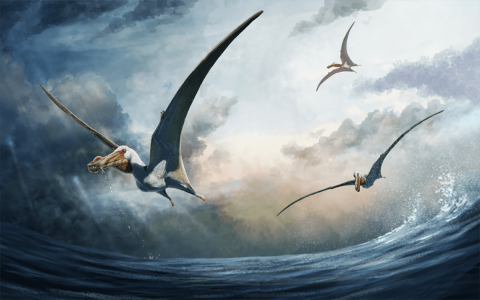Discover the Prehistoric Monster Found in Queensland's Outback That No One Believed Existed!
The Australian outback, with its vast and rugged landscape, has always been a place of mystery and intrigue. It's a land where the echoes of ancient creatures still seem to reverberate through the red dust and under the scorching sun. And now, thanks to the keen eye of a local fossil museum curator and the diligent work of researchers, a new chapter in the story of Australia's prehistoric past has been unearthed.
In the remote expanses of western Queensland, a discovery that has sent ripples through the scientific community was made in 2021. Kevin Petersen, the curator of a local fossil museum, stumbled upon what appeared to be fossilised bones. Little did he know that his find would soon be identified as a new genus and species of a formidable flying reptile that soared through the skies during the age of the dinosaurs.
A team of researchers from Curtin University's School of Earth and Planetary Sciences, led by PhD student Adele Pentland, conducted a thorough study of the bones. Their findings were nothing short of astonishing. The bones belonged to a pterosaur, specifically an anhanguerian, a group of pterosaurs that once spread their wings across the globe, from Brazil to England, and from Morocco to China.

This particular species, which has been named Haliskia, was a true behemoth of the skies with a wingspan of approximately 4.6 metres. Imagine a creature soaring above the ancient waters that once covered central western Queensland, a predator that ruled the air around 100 million years ago. The land that is now a sunbaked outback was, at that time, submerged beneath a vast inland sea, teeming with life.
The significance of this find cannot be overstated. The specimen is 22 per cent complete, making it the most complete pterosaur ever discovered in Australia. Included in the find were complete lower jaws, the tip of the upper jaw, 43 teeth, vertebrae, ribs, bones from both wings, and part of a leg. Remarkably, even delicate throat bones were preserved, suggesting a muscular tongue that would have been adept at snatching fish and cephalopods from the ancient seas.
The discovery of Haliskia is not just a win for paleontology but also for the local community. The pterosaur remains are set to be displayed at Petersen's museum, the Kronosaurus Korner in north-west Queensland. This exhibit will stand alongside a collection of significant marine fossil specimens, turning the museum into a beacon for science, education, and regional tourism.
Kevin Petersen's passion for prehistoric life has been rewarded with the knowledge that his discovery has contributed to shaping our understanding of these ancient species. His excitement is shared by many who understand the importance of such a find, both for the scientific community and for the curious public eager to connect with the planet's distant past.
The research detailing this extraordinary discovery has been published in Scientific Reports - Nature, marking a proud moment for Australian science and for those who believe that the outback still holds many secrets waiting to be discovered.
As we marvel at the thought of Haliskia's great wings casting shadows over the prehistoric seas, we are reminded of the enduring wonder of our natural world and the stories still buried beneath our feet. So, dear members of the Seniors Discount Club, let us celebrate this glimpse into our planet's incredible history and the ongoing quest to uncover the mysteries of the time when giants ruled the skies.
 Have you visited any fossil sites in Australia, or do you have a fascination with prehistoric creatures? Share your experiences and thoughts in the comments below – we'd love to hear your stories!
Have you visited any fossil sites in Australia, or do you have a fascination with prehistoric creatures? Share your experiences and thoughts in the comments below – we'd love to hear your stories!
In the remote expanses of western Queensland, a discovery that has sent ripples through the scientific community was made in 2021. Kevin Petersen, the curator of a local fossil museum, stumbled upon what appeared to be fossilised bones. Little did he know that his find would soon be identified as a new genus and species of a formidable flying reptile that soared through the skies during the age of the dinosaurs.
A team of researchers from Curtin University's School of Earth and Planetary Sciences, led by PhD student Adele Pentland, conducted a thorough study of the bones. Their findings were nothing short of astonishing. The bones belonged to a pterosaur, specifically an anhanguerian, a group of pterosaurs that once spread their wings across the globe, from Brazil to England, and from Morocco to China.

Fossilized bones of a new species of ancient flying reptile were found in Queensland. Image source: Gabriel Ugueto, Curtin University
This particular species, which has been named Haliskia, was a true behemoth of the skies with a wingspan of approximately 4.6 metres. Imagine a creature soaring above the ancient waters that once covered central western Queensland, a predator that ruled the air around 100 million years ago. The land that is now a sunbaked outback was, at that time, submerged beneath a vast inland sea, teeming with life.
The significance of this find cannot be overstated. The specimen is 22 per cent complete, making it the most complete pterosaur ever discovered in Australia. Included in the find were complete lower jaws, the tip of the upper jaw, 43 teeth, vertebrae, ribs, bones from both wings, and part of a leg. Remarkably, even delicate throat bones were preserved, suggesting a muscular tongue that would have been adept at snatching fish and cephalopods from the ancient seas.
The discovery of Haliskia is not just a win for paleontology but also for the local community. The pterosaur remains are set to be displayed at Petersen's museum, the Kronosaurus Korner in north-west Queensland. This exhibit will stand alongside a collection of significant marine fossil specimens, turning the museum into a beacon for science, education, and regional tourism.
Kevin Petersen's passion for prehistoric life has been rewarded with the knowledge that his discovery has contributed to shaping our understanding of these ancient species. His excitement is shared by many who understand the importance of such a find, both for the scientific community and for the curious public eager to connect with the planet's distant past.
The research detailing this extraordinary discovery has been published in Scientific Reports - Nature, marking a proud moment for Australian science and for those who believe that the outback still holds many secrets waiting to be discovered.
As we marvel at the thought of Haliskia's great wings casting shadows over the prehistoric seas, we are reminded of the enduring wonder of our natural world and the stories still buried beneath our feet. So, dear members of the Seniors Discount Club, let us celebrate this glimpse into our planet's incredible history and the ongoing quest to uncover the mysteries of the time when giants ruled the skies.
Key Takeaways
- Researchers from Curtin University have identified a new genus and species of an ancient flying reptile, or pterosaur, from fossils found in Queensland's outback.
- The pterosaur, with a wingspan of approximately 4.6 metres, belonged to the group known as anhanguerians and lived around 100 million years ago when the area was covered by a vast inland sea.
- The fossilised remains are the most complete pterosaur specimen discovered in Australia to date, including lower jaws, teeth, vertebrae, wing bones, and part of a leg.
- The discovery is a significant contribution to science and is expected to benefit education and regional tourism, with the remains set to be displayed at the Kronosaurus Korner museum in north-west Queensland.







